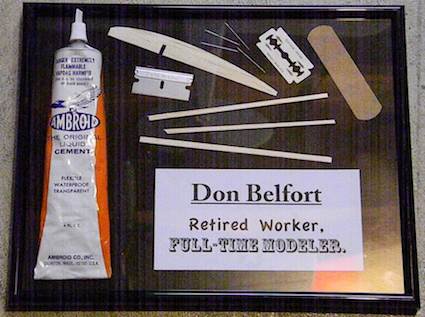 |
Flying High With Electric Power!
The Ampeer ON-LINE!
Fly the Future - Fly Electric! |
Site Table of Contents
| President: | Vice-President: | Secretary/Treasurer: |
| Ken Myers | Richard Utkan | Rick Sawicki |
| 1911 Bradshaw Ct. | 240 Cabinet | 5089 Ledgewood Ct. W. |
| Commerce Twp., MI 48390 | Milford, MI 48381 | Commerce Twp., MI 48382 |
| (248) 669-8124 | (248) 685-1705 | 248.685.7056 |
 | ||
| Board of Directors: | Board of Directors: | Ampeer Editor |
| David Stacer | Arthur Deane | Ken Myers |
| 16575 Brookland Blvd. | 21690 Bedford Dr. | 1911 Bradshaw Ct. |
| Northville, MI 48167 | Northville, MI 48167 | Commerce Twp., MI 48390 |
| 248.924.2324 | 248.348.2058 | 248.669.8124 |
| Mailed Ampeer printed subscriptions are no longer available.
The Ampeer is FREE on-line in Acrobat .pdf format and HTML with active links! | ||
| The Next Meeting:
Date: Saturday, September 8 Time: 10 a.m. Place: Midwest RC Society 7 Mile Rd. Flying Field | ||
| What's In This Issue? | |
| Power System for an OK Model Co. Ltd. Pilot PT-19 Kit , Ken Myers explains one to select a power system for this glow to electric conversion. | Comments On the July 2012 Ampeer Articles "Can the Data From the Castle Creations' Phoenix ICE 50 (8S) Be Used to Collect Inputs for Drive Calculator?" and "A Propeller Quiz", just what the title implies. |
| Introducing RC Aeronauts, Ed DeLaura, President, RC Aeronauts, informs us about this new site. | Don Belfort's Retirement Plaque, Don sent a photo of his special plaque presented to him by Keith Shaw at the 2012 Mid-Am. |
| Indoor Micro Event at the NEAT Fair 2012, Bob Aberle shares info on this upcoming event. | |
|
By Ken Myers Mike, from Athens, Greece, asked about a power system for this model in a thread on RC Groups.
My first response was to ask him about prop clearance. I remembered building one of Pilot's Citabrias for a glow 2-stroke sometime in the early 1980s. The kit went together very well, but it was, in my opinion, "over-built" and weighed more than really necessary. I was concerned that this little PT-19 (418.5 sq.in.) might also be heavier than necessary. The specifications on the plans
Next I did a workup using the glow to electric conversion spreadsheet.
|
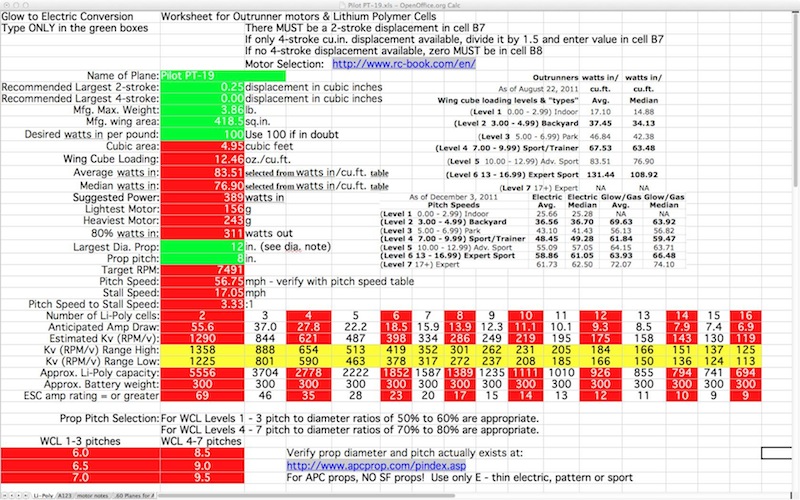
| The spreadsheet suggested 389 watts in (Pin) using a target weight of 3.86 lb. (61.73 oz.).
Mike had a 3S 2200mAh Li-Poly pack that he wished to use. He also noted that the plane could use up to a 12-inch diameter prop.
I tried the data for a 12x8 prop and the spreadsheet suggested a 3S Li-Poly capacity that exceeded the pack that Mike wanted to use, which was a 3S 2200mAh. The spreadsheet suggested a capacity of 3700mAh for the 3S Li-Poly battery with decent flight times. Mike also wrote, "I am not expecting much in terms performance. Pretty much what the full size version is capable of."
One hundred watts in per pound is NOT necessary for scale-like performance of a PT-19. Keith Shaw's rules of thumb for watts in still very much apply. From Keith's 1987 Model Builder Article "Electric Sport Scale" -
"(4) There are rule of thumb estimates for watts; the first two are from Bob Kopski, electric columnist for Model Aviation, the rest are from my experience and observations. Please note the "watts" refer to input power at the motor (volts x amperes). (Note: brushed motor power could be measured between the ESC and motor. Brushless power systems require the power measurement between the ESC and battery. This makes very little practical difference. KM) Our motors are just electrical power to mechanical power converters with typical efficiency of 75%. All watts estimates are relative to the weight of the airplane in pounds (#). Power to hold level flight = wing loading (oz./sq. ft.) times the pounds. Power to take off from the ground = 30 to 50 watts (watts in KM) per pound. Power for sport aerobatics = 40 to 60 watts (watts in KM) per pound (loops, rolls, Cuban eights, stall turn, spin). Power for good aerobatics = 70 to 100 watts (watts in KM) per pound (outsides, knife edge, vertical rolls, turnaround pattern). Needless to say, these values are approximate, suitable to most reasonably clean monoplane designs. Biplanes, planes with full rigging, or heavily under-cambered airfoils are going to have much more drag and take more power to hold level flight. With respect to takeoff, long grass, tricycle gear, small wheels, and high wing loadings will require higher power. Conversely, taildraggers, large wheels, short grass, and light wing loading will require less power." The following ONLY applies to fixed wing models with propellers that spend most of their time "flying on the wing." It does NOT apply to electric ducted fan (EDF) types or "burst fliers" such as 3D aerobatic types or high performance sailplanes and old timers. It also does not apply to Micro types or planes defined by the AMA as Park Flyer types.
A 2200mAh (milliampere hour) battery capacity is a 2.2Ah (2.2 ampere hours) capacity. C-rate is a "factor" times the capacity in Ah. If a fully charged battery is loaded to a 10C static current draw, it takes 60 minutes (1 hour) divided by 10 (the factor) or 6 minutes to "empty". It makes no difference whether the battery has a capacity of 800mAh or 8000mAh. At a constant 10C discharge rate, it will drain from fully charged to empty in 6 minutes. Depending on elevation, weather, the pilot's skill and plane's mission, the flying time is typically about 1.5 times the number of minutes indicated by the static C-rate. 6 minutes x 1.5 (flight time factor) = 9 minutes of anticipated flying time. A 2.2Ah capacity battery times 10 (the C-rate) equals a 22 amp static draw. When using Li-Poly cells, it is recommended that only 80% of the capacity be used. For a 2.2Ah battery that would be 1.76Ah. 1.76Ah x 60 minutes = 105.6 amp minutes divided by 22 amps equals 4.8 minutes times a 1.5 flight time factor for approximately 7.2 minutes of flying, while leaving the battery approximately 20% charged. A 3S 2200mAh pack at a 10C static draw, 22 amps, inputs to the ESC about 22 amps times 11.1v for 244.2 watts in (Pin). 11.1v is used because some point must be chosen and that is 3.7 volts per cell, which coincides with the nominal voltage for a Li-Poly battery. The actual power, when read with a power meter, will be higher near the beginning of the pack discharge. 244.2 watts in divided by 3.86 lb. equals 63.26 watts in per pound for the PT-19 at 3.86 lb.. That power loading should fly the plane in a reasonably scale manner for about 7 minutes with the 3S 2200mAh pack with a measured static draw of approximately 22 amps. At 63.26 watts in per pound, according to Keith's power loading rule of thumb, it should be able to do &qut;sport aerobatics = 40 to 60 watts (watts in KM) per pound (loops, rolls, Cuban eights, stall turn, spin)". Therefore, the 22 amp static draw using a 3S 2200mAh Li-Poly may be considered the minimum amp draw for somewhat decent performance. A 2.2Ah battery at a 15C static draw is 33 amps. 105.6 amp minutes (see above) divided by 33 amps equals 3.2 minutes times a 1.5 flight time factor equals approximately 4.8 minutes or about 5 minutes of flying time. Remember that the 105.6 amp minutes is already reduced to 80% of the packs capacity. A 3S 2200mAh pack at 15C static, 33 amps, inputs about 33 amps times 11.1v for 366.3 watts in (Pin). 366.3 watts in divided by 3.86 lb. equals 94.9 watts in per pound. That power loading should fly the plane beyond scale capabilities for about 5 minutes. The math can be computed from the previous formula. At about a 33 amp static draw, an electronic speed control (ESC) of 1.25 (inverse of 80%) times 33 amps indicates that a 41 amp or greater ESC would be a wise choice. Therefore, a 40-amp electronic speed control would be a reasonable choice since the amp draw should be no more than about 35 amps (33 amps round to the nearest 5 amps) for decent flight time at 15C using a 2.2Ah Li-Poly battery. Outrunner Motor Choices: The weight:
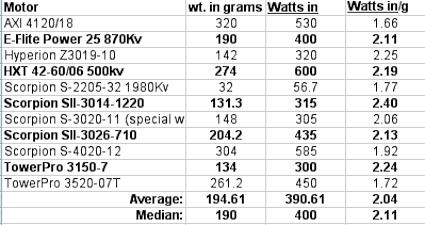
Some of Ken's Personal Power Systems At a maximum of 366.3 watts in for the PT-19, a suggested outrunner motor weight would be the watts in, 366.3, divided by 2 watts in per gram of motor weight or 183g. The prop diameters to consider for this PT-19; 12-inch (previously mentioned as largest physically possible), 11-inch and possibly 10-inch. Keeping the diameter as large as possible works quite well with electrically powered planes. From the same article by Keith Shaw, "Another factor to consider is the diameter/pitch ratio of the prop. A 1:1 ratio may be usable for high speed pylon racers, but for scale planes and aerobatic types 1.3:1 to 1.7:1 are better ratios. For high drag or slow-flying aircraft a 2:1 ratio is more suitable." Props to consider are for the PT-19;
Another important performance predictor, besides watts in per pound, is the flight speed to stall speed ratio. From Keith"s article:
The stall speed of our models depends on the wing loading, airfoil choice and surface contour finish, but fortunately is not a very strong function of any of these. At wing loadings of 14 to 25 oz./sq. ft. and the nominal airfoils used in sport scale, an amazingly reliable stall speed estimate is: Stall speed (mph) = 3.7 x the sq. root of the wing loading (oz./sq.ft.)" Keith's definition of "Speed" is a quick and dirty way (meaning not exactly correct) of determining pitch speed. The approximate stall speed for the PT-19 at 3.86 lb. is 3.7 times the square root of 21.24 oz./sq.ft. (see the Specifications) which equals 17 mph. Keith continued:
PT-19 Stall Speed times 2 = 34 mph
Because of the fairly high, 12.46, wing cube loading (Advanced Sport), 3 times the stall speed (51 mph) might be a little 'slow' to choose for the target pitch speed. The pitch speed table shows the average and median pitch speeds for the wing cube loading levels. |

| A 'better' target pitch speed might be 57 mph or a pitch to stall speed ratio of 3.35:1 It might not be achievable, but it sets a good target.
Required RPM for 60 mph (57 mph rounded up) pitch speed:
A motor's RPM is determined by the Kv (a motor constant) times the net voltage (Vnet). The input voltage is reduced by the current times the resistance. The current times the resistance varies according to the particular battery, motor, ESC, wiring and connectors and the chosen prop (the load). To choose the correct motor Kv the Vnet must be known. The table gives a very rough approximation of Vnets to use to choose a Kv. It is ONLY to be used to determine a Kv or Kv range. It is NOT exact, but will aid in selecting a usable Kv or Kv range. The table also has a column for a 3S pack, like used in this example. 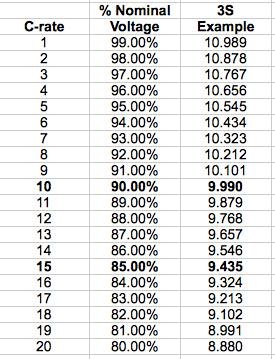 For flying times of 5 minutes (15C static) to 7 minutes (10C static) the C-rates of 10 and 15 have been highlighted in the table. Possible Kv: (voltages are listed in the table)
The possible Kv range is from about 700Kv to 1120Kv. There are many formulas that try to estimate the power out of electric motors. The following formula will NOT estimate any particular motor exactly! It is good enough to use to see whether a given prop should be looked at for a particular application. In this application, 366.3 watts in is the maximum to consider. In the following example, keep in mind that this for a generic prop and only used for estimation purposes! Formula (prop dia./12)^4 * (prop pitch/12) * RPM (in thousands)^3 * 1.1 (a constant for this purpose only)
Watts in are required, but watts out were estimated by the formula. For a generic outrunner the watts out are about 75% of the watts in, at least for calculation purposes. The inverse of 75% is 1.333333. 246.8 watts out * 1.333333 = 329 watts in. A spreadsheet makes the calculations very quick and painless. 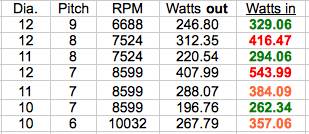 The 12x9, 11x8 and 10x7 should attain the required pitch speed without exceeding the maximum watts in. The 12x9, 11x8 and 10x7 should attain the required pitch speed without exceeding the maximum watts in.
To understand where the Kv numbers were derived, see "Possible Kv" prevously noted in this article. Drive Calculator (www.drivecalc.de) is an excellent, FREE, computer tool to use to verify the calculations before ordering an outrunner motor. The motor does NOT need to be in the Drive Calculator database. Drive Calculator has versions for Windows, Mac and Linux operating systems. Setting up Drive Calculator: Power supply
Motor
Gearbox
Propeller
Example double checking a 12x9 prop with an outrunner motor weighing about 183g and a Kv between 700 and 750 as suggested by the previous calculations. A screen capture of this example is below. |
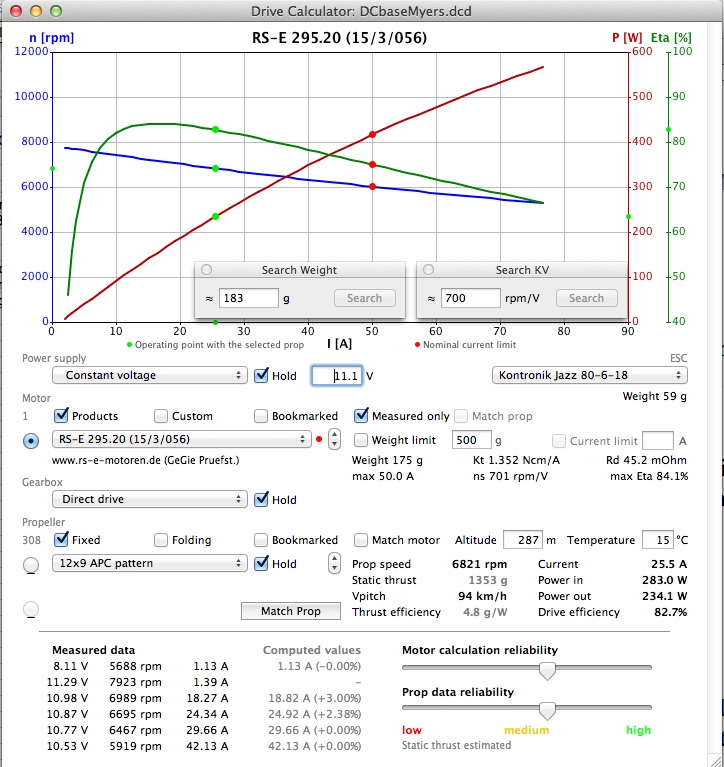
| Double-click on the word weight UNDER where it says Weight limit in the motor line. Do NOT double-click on Weight limit. A Search Weight box will open. Type 183 and click on Search. Only motors in the 183g range will appear in the drop-down Motor list.
To refine the search, double-click where it says ns xxx rpm/V (xxx represents that digits that may appear there) and the Search Kv box opens. For the 12x9 prop, type 700 in the Search Kv box and click Search. In the propeller drop-down list select 12x9 APC pattern. It is the only 12x9 in the list. Some versions of Drive Calculator may list it as Sport, but there is not a sport version, only a pattern version. Investigate the Motor drop-down list. If more than one motor is presented in the list, use all of the outrunners and note the results. For the 12x9 APC pattern at 11.1v there is only one motor listed. The results are shown in the screen capture on the next page. The Search Weight and Search KV boxes have been moved up onto the graph for clarity. It looks like a 700Kv outrunner motor might be a good choice as the amps, watts in and Vpitch (pitch speed) are all in range. 94 km/h is 58.28 mph. Next type 750 in the Search Kv box and click Search. Again there is only one outrunner in the listed motors. It is the 178g AXI 2826-12. Drive Calculator's predictions show Power in 312.3 W at Current 28.1 A with an RPM of 6956 for a pitch speed of 58.9 mph. If a 12x9 prop is desired for use, a favorite outrunner motor vendor or brand my now be checked for an outrunner weighing about 183g and with a Kv between 700 and 750. Motor Examples for a 12x9 prop: Turnigy Aerodrive SK3 - 3548-700kv 177g, 700Kv
Turnigy G15 Brushless Outrunner 710kv 170g, 710Kv
Turnigy Aerodrive SK3 - 4240-740kv 195g, 740Kv
Cobra C-3515-18 Brushless Motor, Kv=740 178g, 740Kv
The 12x8 prop was investigated using a 12x8 APC E with Kvs between 790Kv and 840Kv. Two of the three outrunner motors in Drive Calculator showed the watts in and amp draw to be too high at the 840Kv level. At the lower end of the Kv level, around 800Kv, the Vpitch speed was in the low 50 mph range, a bit low for this project and it appears that the 12x8 is not a good choice here. The 12x7 was investigated using a 12x7 APC sport prop with Kvs between 900Kv and 960Kv. Both of the motors with about a 900Kv drew too many amps. Lowering the Kv did not provide enough pitch speed. Again, this was not a good choice for this project. 11-inch Diameter Examples: The 11x8 was investigated using an 11x8 APC E between 790Kv and 840 Kv. Two of the three outrunner motors found in the Drive Calculator drop-down motor list verified the Kv range with the desired pitch speed. Example motor:
The 11x7 was investigated using a 11x7 APC E between 900 Kv and 960 Kv. The two outrunner motors in Drive Calculator predicted power and Vpitch in the usable range. Examples motors:
NTM Prop Drive 35-48 Series 900KV 171g, 900Kv
Scorpion SII-3020-890 166g, 890Kv
Cobra C-3515-14 Brushless Motor 178g, 950Kv www.innov8tivedesigns.com/product_info.php?cPath=21_120_123&products_id=846&osCsid=3601e9eb3fe878283c323834505f8ca9 10-inch Diameter Examples The 10x7 was investigated using a 10x7 APC E between 900 Kv and 960 Kv. Drive calculator confirmed that this prop could be used with the same motors as the 11x7E prop with a reduced power input but still a good Vpitch speed of about 56 mph. This prop would give the longest motor runtime with appropriate pitch speed. It would also be a good reason to consider a 900Kv to 960Kv outrunner motor. There should be a lot of props available that will provide the proper power and Vpitch speed. The Cobra C3515/14 Motor Propeller Data (innov8tivedesigns.com/Cobra/Cobra_3515-14_Specs.htm) shows propeller data that applies to many 900Kv to 960Kv 180g motors and the range of props with power in and pitch speed. The 10x6 was investigated using an 10x6 APC sport prop between 1040 Kv and 1120 Kv. The Drive Calculator predictions confirmed that this Kv range has very limited potential. After investigating the various props in Drive Calculator, it appears that outrunner motors of about 183g and with Kvs between 900 and 960 are very useful for the purpose of powering the PT-19. Motors with this weight and Kv range allow for the largest selection of props to balance the power in (duration and performance) and pitch speed (performance) to the pilot's desires. Finally, Mike has a Turnigy G25 Brushless Outrunner 870kv 193g, 870Kv available.
Drive Calculator's predictions for a 193g outrunner with an 870Kv shows that many props, of various brands, between a 12x7 and 10x7 will work within the power range and target pitch speed. Mike's motor, with a Kv of 870, is close enough to the 900Kv to 960Kv range to be included in that 'group'. The 3S 2200mAh Li-Poly, 40-amp ESC and Turnigy G25 outrunner should work well for Mike in his PT-19. Comments On the July 2012 Ampeer Articles "Can the Data From the Castle Creations' Phoenix ICE 50 (8S) Be Used to Collect Inputs for Drive Calculator?" and "A Propeller Quiz" From Roger Wilfong, EFO member via email
1) The eMeter and the ICE are not reading current in the same circuit. For one thing, the RDU is seeing the ICE's input capacitors which will tend to smooth out not just the terminal voltage at the input to the ICE, but also the current drawn by the ESC. As the instantaneous current draw increases, the caps will supply some of the current, maintaining a more constant voltage - when the ESC's current draw drops, the caps will continue drawing current to replenish their charge. The RDU is seeing this "filtered" current draw. The ICE's sensor will not see this averaging effect, but will see the instantaneous current changes - which may be higher or lower than average for any given condition. 2) The eMeter's sample period may be longer than the ICE's. We don't know the sample size for either meter. The ICE is set to a sample frequency of 2/sec, but the actual sample time for the ADC may be only a few milliseconds (or less). The ADC is almost certainly a hardware, and not a software implementation (that is, the main processor is only involved in starting and reading the ADC, it is not directly performing the conversion). But, the processor in the ICE is doing several things in sequence (commutation, pulse width modulation, logging, etc.). It is possible that the ADC is being trigged at the same point in the commutation cycle regardless of the motor load or speed. Therefore, as the speed and load changes, the actual sample may be obtained at different times in the commutation cycle. There's a saying in instrumentation that all instruments lie. Bald face lies come cheap. If you want really subtle lies, you have to pay a lot. The majority of the work in physics experiments is eliminating as many of the lies as possible. I think of the instrumentation in the ICE as cheap. The ICE is an ESC, not a Whatt Meter. It primarily measures voltage and current so it can do run the motor and keep from burning itself out - the logging function is a byproduct and will probably never be as good as a Whatt meter or the eMeter. From Jim Cross, EFO member via email
From Andy Kunz, Ampeer reader via email
From Ed DeLaura, President, RC Aeronauts Email: rcaeronauts@yahoo.com RC Aeronauts is dedicated to creating more enjoyment and promoting better decisions in the building and flying of RC model airplanes. We will do this by improving the understanding of aerodynamic flight principles such as pitch stability and maneuverability, and providing innovative tools that make it easier to set up airplanes effectively and optimize flight performance. Our initial project was the development of the CG Optimizer, a Windows program that anyone can use to tailor the flight performance of an airplane to their flying skills and the type of flying they like to do. It overcomes some serious shortcomings of so-called free calculators, easily analyzes any wing and tail shape in seconds and does all the math. This is the kind of high-quality tool that we are also developing in other important aspects of RC modeling. It's easy to get the best flight performance and more enjoyment from any single- or multi-panel wing airplane, for the type of flying you like to do. We invite you to visit our website (www.rcaeronauts.com) and see how it is done.
Last month I asked if anyone had a photo of Don's plaque, given to him by Keith Shaw at the Mid-Am. I received this photo and a thank you note. KM Hi Ken, Thanks for everything and a great time! From Bob Aberle via email On Saturday of the NEAT Fair, Sept. 15, there will be an indoor session for micro models to be flown at the local Downsville High School. It will run from 2:00 to 10:00 PM. It will feature open flying, demo flying a a series of micro seminars from many experts who will attend. The high school is located only 10 minutes from the actual NEAT Fair.
|
To Reach Ken Myers, you can land mail to the address at the top of the page. My E-mail
address is:
kmyersefo@theampeer.org
EFO WEB site: http://www.theampeer.org
